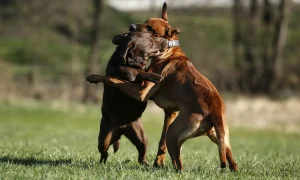Dogs Play Fighting: When to Step In and When to Let Them Be
Dogs Play Fighting

Play fighting among dogs is a common behavior that often leaves pet owners wondering whether they should intervene or allow their furry friends to continue. It’s a natural aspect of canine behavior that serves various purposes, including socialization, exercise, and communication. However, as a responsible pet owner, it’s essential to understand when play fighting crosses the line into aggression and when it’s harmless fun. In this blog, we’ll delve into the intricacies of dogs play fighting, offering insights into when to step in and when to let them be.
The Nature of Dogs Play Fighting:
 Dogs Play fighting, also known as social play, is a vital part of canine development, especially during puppyhood. It involves mock combat behaviors, such as chasing, wrestling, and mouthing, without causing harm or injury. Through play fighting, dogs learn valuable social skills, including bite inhibition, body language interpretation, and boundaries. Additionally, it provides mental stimulation and physical exercise, contributing to their overall well-being.
Dogs Play fighting, also known as social play, is a vital part of canine development, especially during puppyhood. It involves mock combat behaviors, such as chasing, wrestling, and mouthing, without causing harm or injury. Through play fighting, dogs learn valuable social skills, including bite inhibition, body language interpretation, and boundaries. Additionally, it provides mental stimulation and physical exercise, contributing to their overall well-being.
Recognizing Playful Signals:
Understanding the subtle cues that distinguish playful behavior from aggression is crucial for pet owners. During dogs play fighting, dogs typically exhibit relaxed body postures, including loose, wagging tails, open mouths, and soft vocalizations such as barks or growls. Their movements are often exaggerated and bouncy, and they may take turns being the “chaser” and the “chasee.” It’s essential to observe the context and the demeanor of the dogs involved to determine whether their interactions are playful or escalating into something more serious.
When to Step In:
While play fighting is generally harmless, there are instances where intervention may be necessary:
- Unequal Matches: If one dog significantly outweighs or dominates the other, it’s crucial to monitor their interactions closely. The smaller or less assertive dog may feel overwhelmed or intimidated, leading to potential distress or injury. In such cases, redirect their attention with a toy or verbal command to diffuse any tension.
- Intensity Escalation: Play should remain gentle and controlled. If the intensity of dogs play fighting increases, with one or both dogs becoming overly rough or vocal, it’s time to intervene. Separating them briefly or redirecting their focus can help prevent any escalation into aggression.
- Discomfort or Fear: Pay attention to signs of discomfort or fear in either dog, such as ears pinned back, tail tucked, or attempts to escape. These behaviors indicate that one or both dogs may not be enjoying the interaction. Remove them from the situation and provide a calming environment to alleviate any stress.
- Resource Guarding: If dogs play fighting escalates due to resource guarding behavior, such as possessiveness over toys or food, it’s essential to address the underlying issue. Remove the object of contention and work on training to modify the dogs’ behavior around resources.
- Injury or Distress: Any signs of injury or distress, such as yelps, whimpers, or limping, warrant immediate intervention. Separate the dogs and assess the extent of the injury. Seek veterinary care if necessary and provide a safe environment for recovery.
When to Let Them Be:
In most cases, dogs play fighting is a normal and healthy part of their social interaction. Here are instances where intervention may not be required:
- Mutual Consent: Dogs engaged in play typically exhibit reciprocal behaviors, with both parties willingly participating. If both dogs are actively engaging in play, taking turns being the “instigator,” and showing no signs of distress, it’s best to allow them to continue their interaction.
- Age-Appropriate Behavior: Puppies often engage in rough-and-tumble play as they explore their boundaries and learn social skills. As long as the play remains within appropriate limits and both parties are enjoying themselves, there’s no need for intervention. However, adult dogs may still engage in playful behavior, which is normal and beneficial.
- Positive Socialization: Play fighting allows dogs to learn important social cues and boundaries from a young age. It promotes healthy relationships with other dogs and can prevent behavioral issues later in life. Allowing dogs to engage in supervised play fosters positive socialization experiences and strengthens their bond with each other.
- Physical Exercise: Dogs Play fighting serves as a form of physical exercise, helping dogs burn excess energy and maintain a healthy weight. Allowing them to engage in playful interactions contributes to their overall well-being and can reduce boredom and destructive behavior.
- Bonding and Communication: Dogs often use play fighting as a means of bonding and communication. It strengthens their social bonds with each other and with their human companions. By allowing them to engage in play, you’re facilitating healthy communication and reinforcing their relationship.
Skipper’s Brand: Providing Nutritious Support for Playful Pups
In the realm of pet care, Skipper’s brand stands out as a beacon of quality and nutritional excellence. With a commitment to providing pets with wholesome, balanced diets, Skipper’s offers a range of premium pet food products designed to support the health and vitality of dogs of all ages and breeds. From delectable kibbles packed with essential nutrients to mouthwatering treats that promote dental health, Skipper’s brand prioritizes the well-being of furry companions.
What sets Skipper’s apart is not just its dedication to crafting nutritious meals but also its holistic approach to pet care. Understanding that a healthy diet is just one aspect of a dog’s overall wellness, Skipper’s brand goes above and beyond to educate pet owners on various aspects of canine health and behavior. Through informative content, including blogs, articles, and social media posts, Skippers empowers pet owners to make informed decisions about their pets’ care, including understanding the nuances of dogs play fighting.
Conclusion:
In conclusion, dogs play fighting is a natural and beneficial behavior that facilitates socialization, exercise, and communication. As pet owners, it’s essential to recognize the signs of playful interaction and differentiate them from potential aggression. Knowing when to intervene and when to allow dogs to continue their playful antics is crucial for fostering positive relationships and ensuring their well-being. With the right knowledge and guidance, pet owners can support their furry friends as they engage in enriching play experiences, strengthening the bonds of companionship for years to come. And with the nutritional support and educational resources provided by brands like Skipper’s, pet owners can rest assured that they’re giving their dogs the best possible care.









